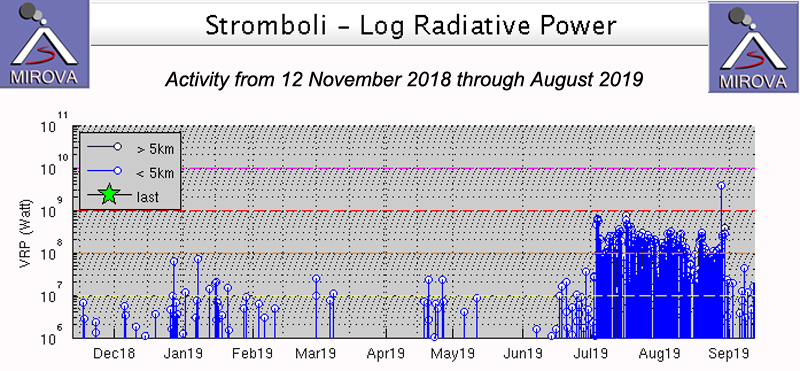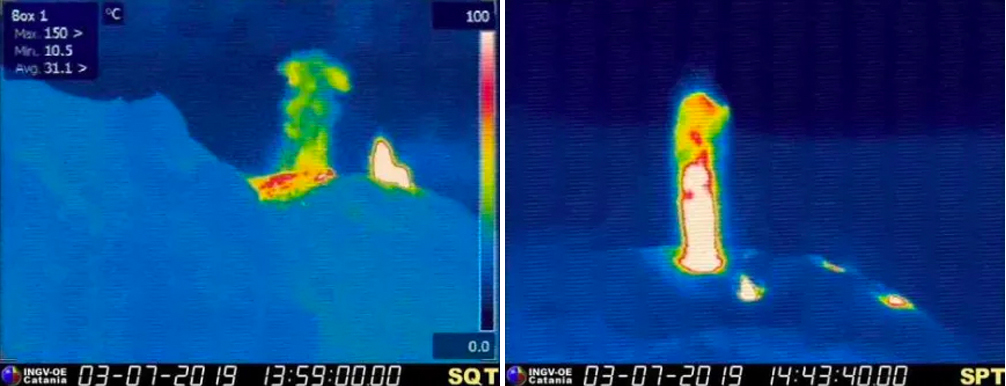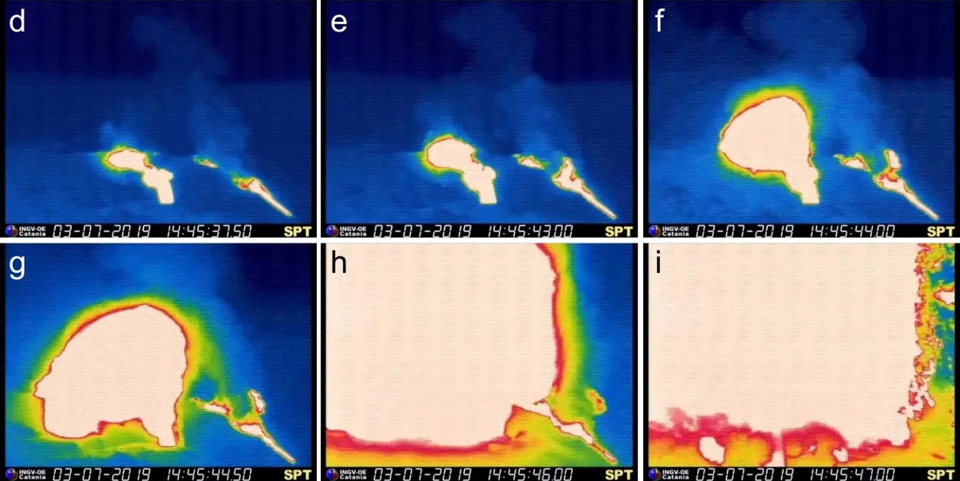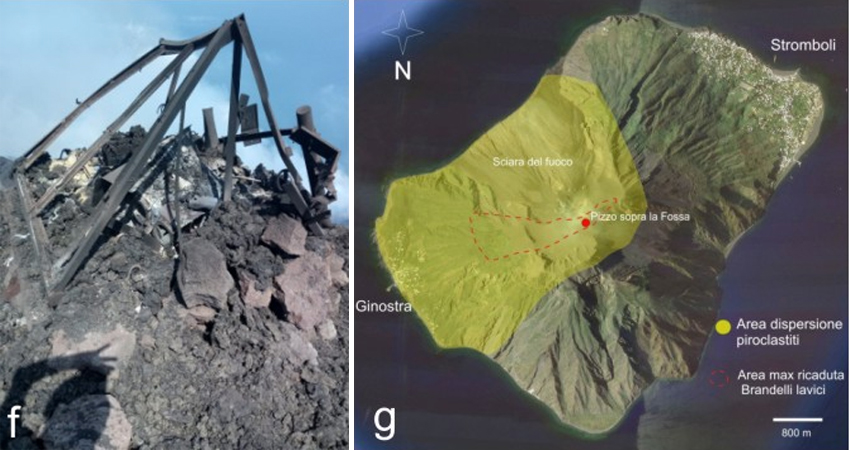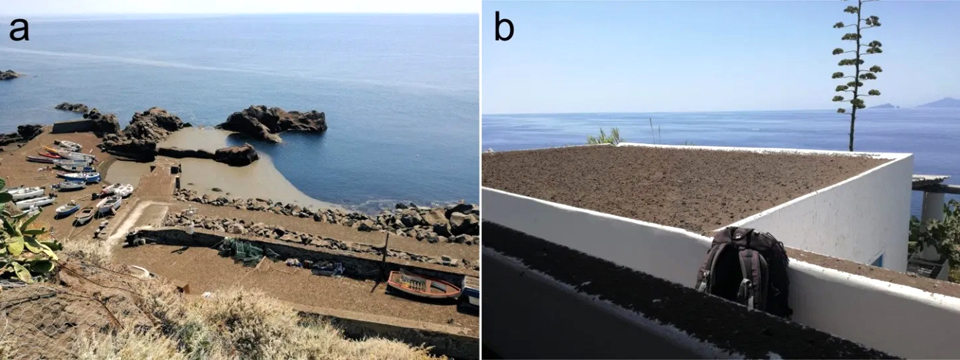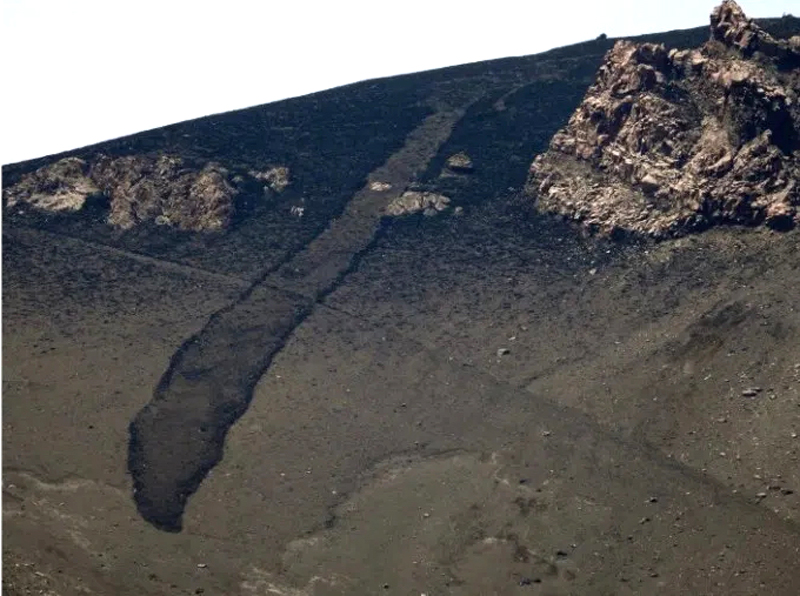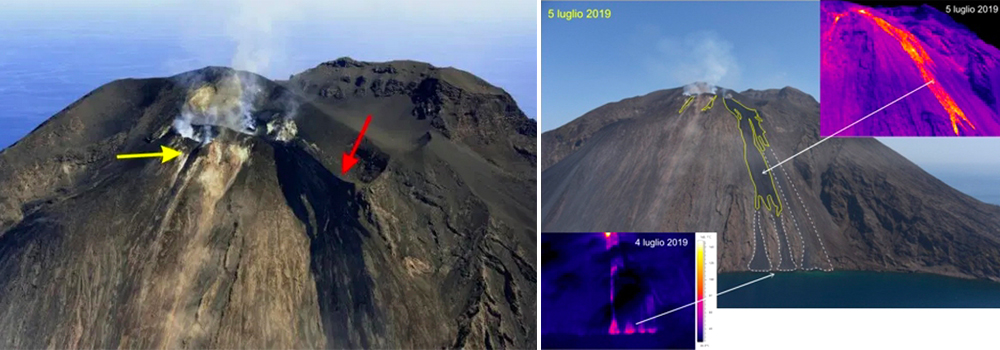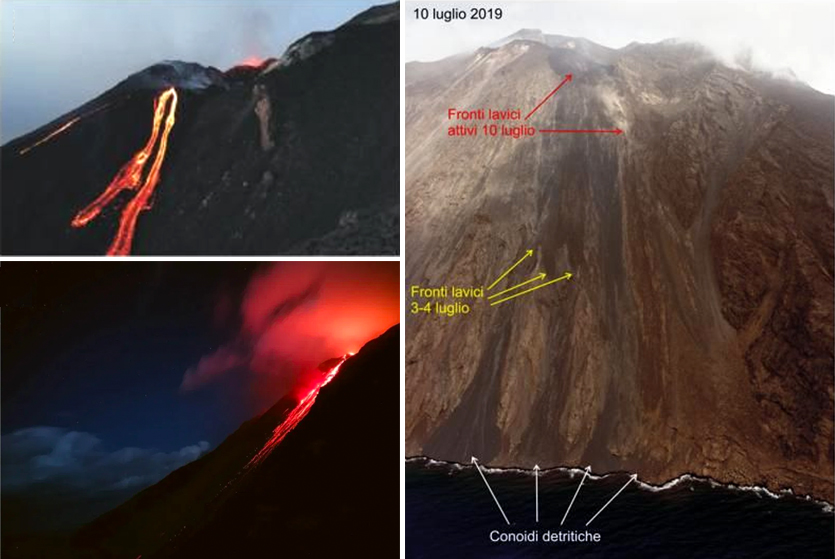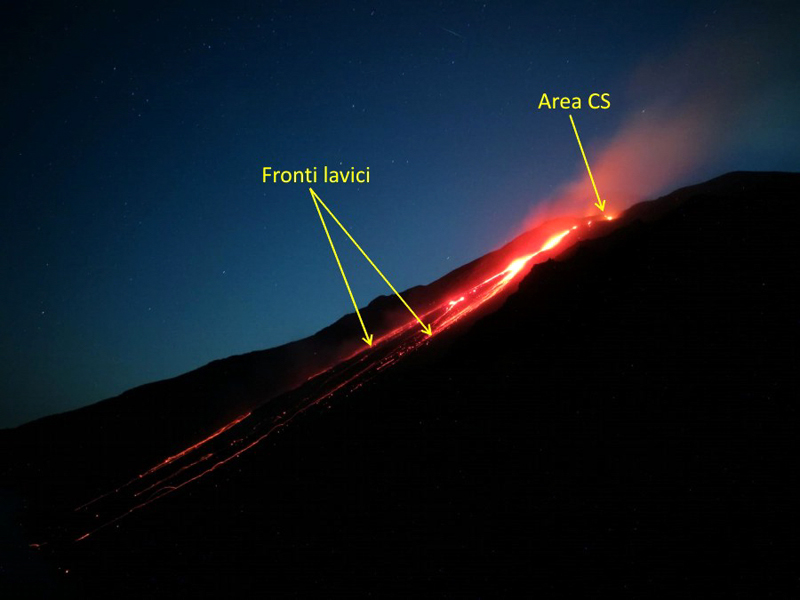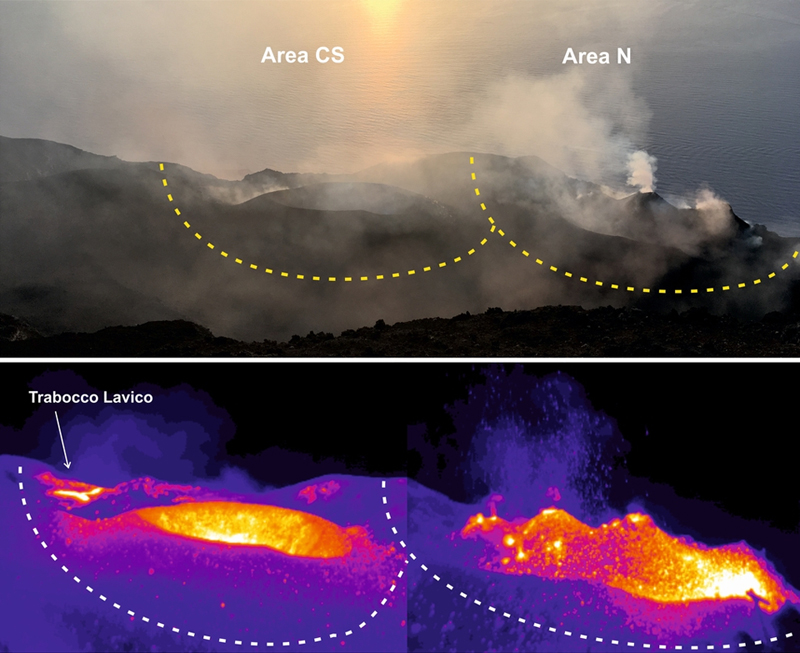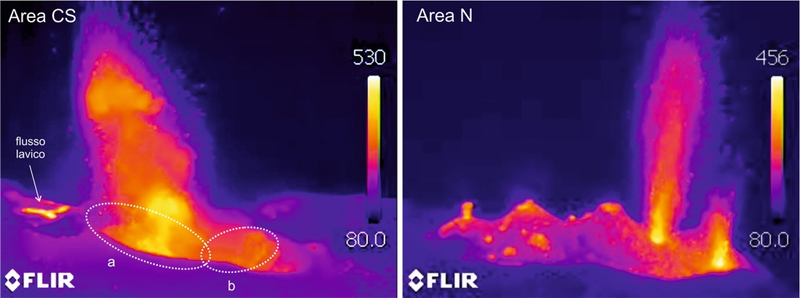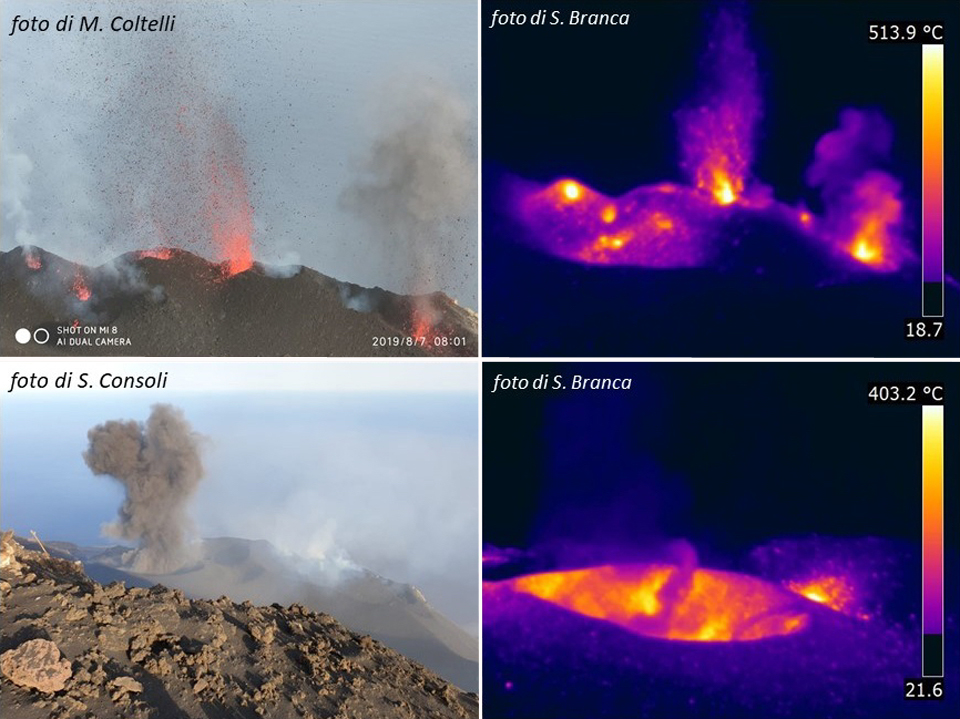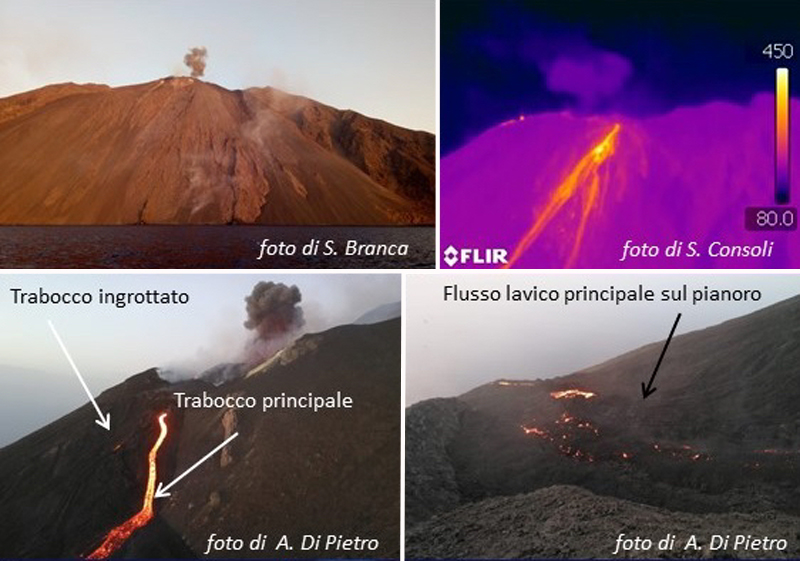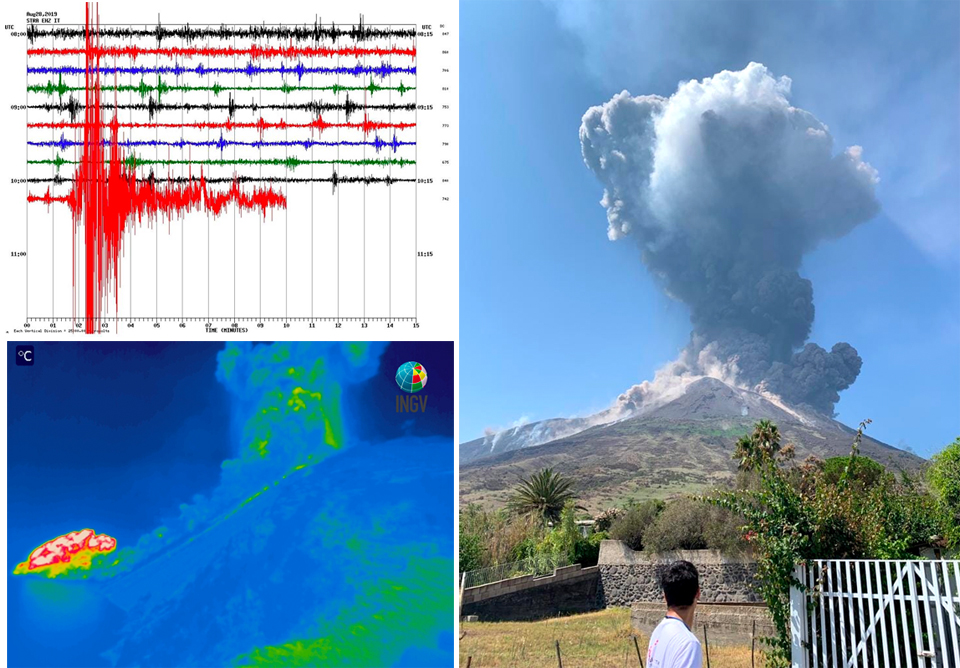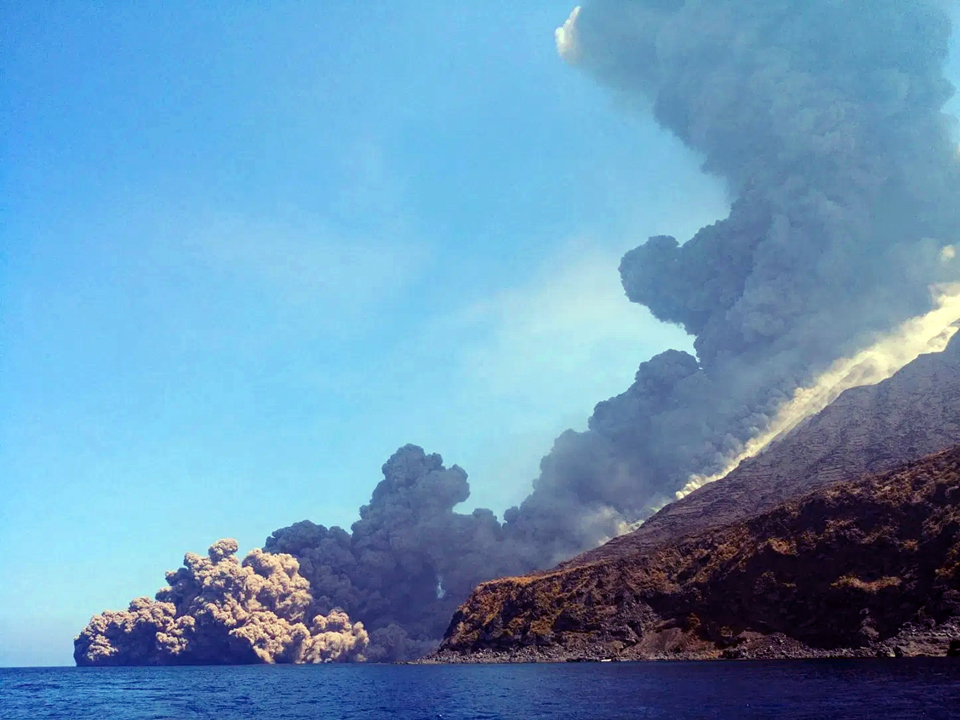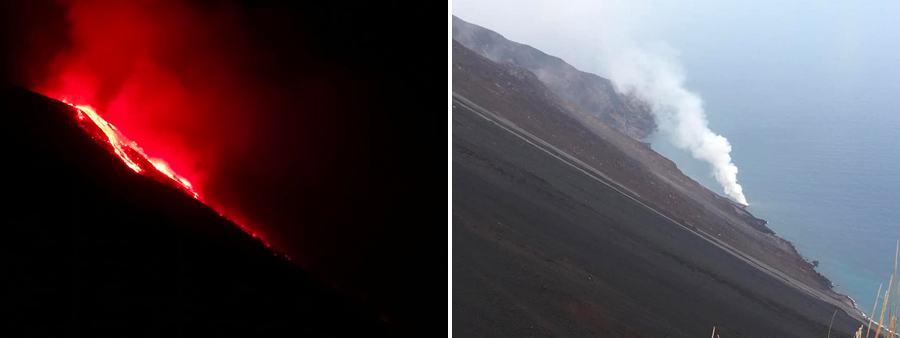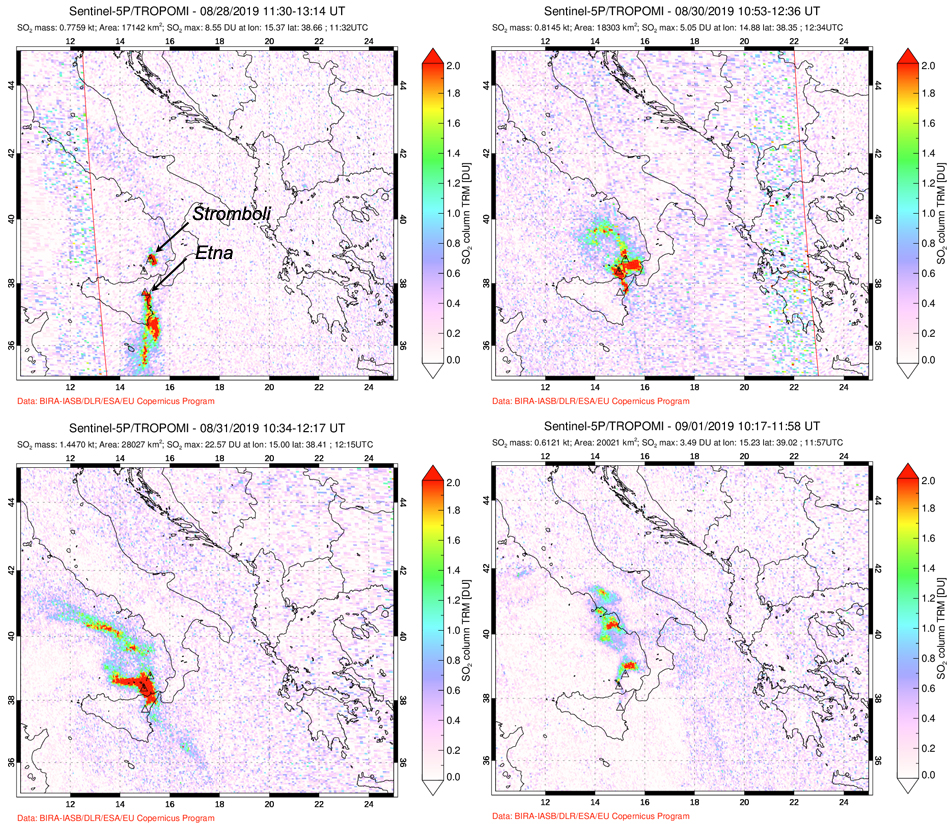Report on Stromboli (Italy) — September 2019
Bulletin of the Global Volcanism Network, vol. 44, no. 9 (September 2019)
Managing Editor: Edward Venzke.
Edited by A. Elizabeth Crafford.
Stromboli (Italy) Major explosions on 3 July and 28 August 2019; hiker killed by ejecta
Please cite this report as:
Global Volcanism Program, 2019. Report on Stromboli (Italy) (Crafford, A.E., and Venzke, E., eds.). Bulletin of the Global Volcanism Network, 44:9. Smithsonian Institution. https://doi.org/10.5479/si.GVP.BGVN201909-211040
Stromboli
Italy
38.789°N, 15.213°E; summit elev. 924 m
All times are local (unless otherwise noted)
Near-constant fountains of lava at Stromboli have served as a natural beacon in the Tyrrhenian Sea for at least 2,000 years. Eruptive activity at the summit consistently occurs from multiple vents at both a north crater area (N area) and a southern crater group (CS area) on the Terrazza Craterica at the head of the Sciara del Fuoco, a large scarp that runs from the summit down the NW side of the volcano-island. Periodic lava flows emerge from the vents and flow down the scarp, sometimes reaching the sea; occasional large explosions produce ash plumes and pyroclastic flows. Thermal and visual cameras that monitor activity at the vents are located on the nearby Pizzo Sopra La Fossa, above the Terrazza Craterica, and at multiple locations on the flanks of the volcano. Detailed information for Stromboli is provided by Italy's Istituto Nazionale di Geofisica e Vulcanologia (INGV) as well as other satellite sources of data; March-August 2019 is covered in this report.
Typical eruptive activity recorded at Stromboli by INGV during March-June 2019 was similar to activity of the past few years (table 6); two major explosions occurred in July and August with a fatality during the 3 July event. In the north crater area, both vents N1 and N2 emitted fine (ash) ejecta, occasionally mixed with coarser lapilli and bombs; most explosions rose less than 80 m above the vents, some reached 150 m. Average explosion rates ranged from 1 to 12 per hour. In the CS crater area continuous degassing and occasional intense spattering were typical at vent C, vent S1 was a low-intensity incandescent jet throughout the period. Explosions from vent S2 produced 80-150 m high ejecta of ash, lapilli, and bombs at average rates of 2-17 per hour.
After a high-energy explosion and lava flow on 25 June, a major explosion with an ash plume and pyroclastic flow occurred on 3 July 2019; ejecta was responsible for the death of a hiker lower down on the flank and destroyed monitoring equipment near the summit. After the explosion on 3 July, coarse ejecta and multiple lava flows and spatter cones emerged from the N area, and explosion rates increased to 4-19 per hour. At the CS area, lava flows emerged from all the vents and spatter cones formed. Explosion intensity ranged from low to very high with the finer ash ejecta rising over 250 m from the vents and causing ashfall in multiple places on the island. This was followed by about 7 weeks of heightened unrest and lava flows from multiple vents. A second major explosion with an ash plume and pyroclastic flow on 28 August reshaped the summit area yet again and scattered pyroclastic debris over the communities on the SW flank near the ocean.
Table 6. Summary of activity levels at Stromboli, March-August 2019. Low-intensity activity indicates ejecta rising less than 80 m, medium-intensity is ejecta rising less than 150 m, and high-intensity is ejecta rising over 200 m above the vent. Data courtesy of INGV.
| Month | North (N) Area Activity | Central-South (CS) Area Activity |
| Mar 2019 | Low- to medium-intensity explosions at both N1 and N2. Coarse-grained ejecta (lapilli and bombs) from N1, fine-grained ash mixed with coarse material from N2. Explosion rates of 3-12 per hour. | Medium-intensity explosions from both S area vents, lapilli and bombs mixed with ash, 2-9 explosions per hour. |
| Apr 2019 | Low- to medium-intensity explosions at both N1 and N2. Coarse-grained ejecta (lapilli and bombs) from N1, fine-grained ash from N2. Explosion rates of 5-12 per hour. | Continuous degassing from C, low-intensity incandescent jets form S1, up to 4 emission points from S2, mostly fine-grained ejecta, 4-15 explosions per hour. |
| May 2019 | Low- to medium-intensity explosions at both N1 and N2. Mostly fine-grained ejecta, occasionally mixed with coarser material. Explosion rates of 2-8 per hour. | Continuous degassing from C, low-intensity incandescent jets form S1, low- to medium-intensity explosions from C, S1, and S2. Mostly fine-grained ejecta, occasionally mixed with coarser material. Explosion rates of 5-16 per hour. |
| June 2019 | Low- to medium-intensity explosions at both N1 and N2. Mostly fine-grained ejecta, occasionally mixed with coarser material. Explosion rates of 1-12 per hour. | Continuous degassing at C and sporadic short duration spattering events, low- to medium-intensity incandescent jets at S1, multiple emission points from S2. Ejecta of larger lapilli and bombs mixed with ash. Explosion rates of 2-17 per hour. High-energy explosion on 25 June. |
| Jul 2019 | Low- to medium-intensity explosions at both N1 and N2. Coarse ejecta after major explosion on 3 July. Intermittent intense spattering. Explosions rates of 4-19 per hour. Lava flows from all vents. | Major explosion and pyroclastic flow, 3 July, with fatality from falling ejecta. Lava flows from all vents. Continuous degassing and variable intensity explosions from low to very high (over 200 m). Coarse ejecta until 20 July; followed by mostly ash. |
| Aug 2019 | Low- to medium-intensity explosions from the N area, coarse ejecta and occasional intense spattering. Explosion rates of 7-17 per hour. Lava flows. | Low- to high-intensity explosions; ash ejecta over 200 m; ashfall during week 1 in S. Bartolo area, Scari, and Piscità. Major explosion on 28 August, with 4-km-high ash plume and pyroclastic flow; lava flows. Explosion rates of 4-16 per hour. |
Thermal activity was low from March through early June 2019 as recorded in the MIROVA Log Radiative Power data from MODIS infrared satellite information. A sharp increase in thermal energy coincided with a large explosion and the emergence of numerous lava flows from the summit beginning in late June (figure 144). High heat-flow continued through the end of August and dropped back down at the beginning of September 2019 after the major 28 August explosion.
Activity during March-June 2019. Activity was low during March 2019. Low- to medium-intensity explosions occurred at both vents N1 and N2 in the north area. Ejecta was mostly coarse grained (lapilli and bombs) from N1 and fine-grained ash mixed with some coarse material from N2. Intense spattering activity was reported from N2 on 29 March. Explosion rates were reported at 5-12 per hour. At the CS area, medium-intensity explosions from both south area vents produced lapilli and bombs mixed with ash at a rate of 2-9 explosions per hour.
During a visit to the Terrazza Craterica on 2 April 2019, degassing was visible from vents N1, N2, C, and S2; activity continued at similar levels to March throughout the month. Low- and medium-intensity explosions with coarse ejecta, averaging 3-12 per hour, were typical at vent N1 while low-intensity explosions with fine-grained (ash) ejecta occurred at a similar rate from N2. Continuous degassing was observed at the C vent, and low-intensity incandescent jets were present at S1 throughout the month. Multiple emission points from S2 (as many as 4) produced low- to medium-intensity explosions at rates of 4-14 explosions per hour; the ejecta was mostly fine-grained mixed with some coarse material. Frequent explosions on 19 April produced abundant pyroclastic material in the summit area.
Low to medium levels of explosive activity at all of the vents continued during May 2019. Emissions consisted mostly of ash occasionally mixed with coarser material (lapilli and bombs). Rates of explosion were 2-8 per hour in the north area, and 5-16 per hour in the CS Area. Explosions of low-intensity continued from all the vents during the first part of June at rates averaging 2-12 per hour, although brief periods of high-frequency explosions (more than 21 events per hour) were reported during the week of 10 June. Strong degassing was observed from crater C during an inspection on 12 June (figure 145); by the third week, continuous degassing was interrupted at C by sporadic short-duration spattering events.
Late on 25 June 2019, a high-energy explosion that lasted for 28 seconds affected vent C in the CS area. The ejecta covered a large part of the Terrazza Craterica, with abundant material landing in the Valle della Luna. An ash plume rose over 250 m after the explosion and drifted S. After that, explosion frequency varied from medium-high (17/hour) on 25 June to high (25/hour) on 28 June. On 29 June researchers inspected the summit and noted changes from the explosive events. Thermal imagery indicated that the magma level at N1 was almost at the crater rim. The magma level at N2 was lower and explosive activity was less intense. At vent C, near-constant Strombolian activity with sporadic, more intense explosions produced black ash around the enlarged vent. At vent S2, a pyroclastic cone at the center of the crater produced vertical jets of gas, lapilli, and bombs that exceeded 100 m in height (figure 146).
Activity during July 2019. A large explosion accompanied by lava and pyroclastic flows affected the summit and western flank of Stromboli on 3 July 2019. Around 1400 local time an explosion from the CS area generated a lava flow that spilled onto the upper part of the Sciara del Fuoco. Just under an hour later several events took place: lava flows emerged from the C vent and headed E, from the N1 and N2 vents and flowed N towards Bastimento, and from vent S2 (figure 147). The emergence of the flows was followed a minute later by two lateral blasts from the CS area, and a major explosion that involved the entire Terrazza Craterica lasted for about one minute (figure 148). Within seconds, the pyroclastic debris had engulfed and destroyed the thermal camera located above the Terrazza Craterica on the Pizzo Sopra La Fossa and sent a plume of debris across the W flank of the island (figure 149). Two seismic stations were also destroyed in the event. The Toulouse VAAC reported a plume composed mostly of SO2 at 9.1 km altitude shortly after the explosion. They noted that ash was present in the vicinity of the volcano, but no significant ashfall was expected. INGV scientists observed the ash plume at 4 km above the summit.
Two pyroclastic flows were produced as a result of the explosions; they traveled down the Sciara and across the water for about 1 km before collapsing into the sea (figure 150). A hiker from Sicily was killed in the eruption and a Brazilian friend who was with him was badly injured, according to a Sicilian news source, ANSA, and the New York Post. They were hit by flying ejecta while hiking in the Punta dei Corvi area, due W of the summit and slightly N of Ginostra, about 100 m above sea level according to INGV. Most of the ejecta from the explosion dispersed to the WSW of the summit. Fallout also ignited vegetation on the slopes which narrowly missed destroying structures in the town. Ejecta blocks and bombs tens of centimeters to meters in diameter were scattered over a large area around the Pizzo Sopra La Fossa and the Valle della Luna in the direction of Ginostra. Smaller material landed in Ginostra and was composed largely of blonde pumice, that floated in the bay (figure 151). The breccia front of the lava flows produced incandescent blocks that reached the coastline. High on the SE flank, the abundant spatter of hot pyroclastic ejecta coalesced into a flow that moved 200-300 m down the flank before cooling, crossing the path normally used by visitors to the summit (figure 152).
INGV scientists inspected the summit on 4 and 5 July 2019 and noted that the rim of the Terrazza Craterica facing the Sciara del Fuoco in both the S and N areas had been destroyed, but the crater edge near the central area was not affected. In addition, the N area appeared significantly enlarged and deepened, forming a single crater where the former N1 and N2 vents had been located; an incandescent jet was active in the CS area (figure 153). Explosive activity declined significantly after the major explosions, although moderate overflows of lava continued from multiple vents, especially the CS area where the flows traveled about halfway down the southern part of the Sciara del Fuoco; lava also flowed E towards Rina Grande (about 0.5 km E of the summit). The main lava flows active between 3 and 4 July produced a small lava field along the Sciara del Fuoco which flowed down to an elevation of 210 m in four flows along the S edge of the scarp (figure 154). Additional block avalanches rolled to the coastline.
During the second week of July lava flows continued; on 8 July volcanologists reported two small lava flows from the CS area flowing towards the Sciara del Fuoco. A third flow was noted the following day. The farthest flow front was at about 500 m elevation on 10 July, and the flow at the center of the Sciara del Fuoco was at about 680 m. An overflow from the N area during the evening of 12 July produced two small flows that remained high on the N side of the scarp; lava continued flowing from the CS area into the next day. A new flow from the N area late on 14 July traveled down the N part of the scarp (figure 155).
A new video station with a thermal camera was installed at Punta dei Corvi, a short distance N of Ginostra on the SW coast, during 17-20 July 2019. During the third week of July lava continued to flow from the CS crater area onto the southern part of the Sciara del Fuoco, but the active flow area remained on the upper part of the scarp; block avalanches continuously rolled down to the coastline (figure 156). During visits to the summit area on 26 July and 1 August activity at the Terrazza Craterica was observed by INGV scientists. There were at least six active vents in the N area, including a scoria cone and an intensely spattering hornito; the other vents were ejecting coarse material in jets of Strombolian activity. In the CS area, a large scoria cone was clearly visible from the Pizzo, with two active vents generating medium- to high-intensity explosions rich in volcanic ash mixed with coarse ejecta (figures 157 and 158). Some of the finer-grained material in the jets reached 200 m above the vents. A second smaller cone in the CS area faced the southernmost part of the Sciara del Fuoco and produced sporadic low-intensity "bubble explosions." Effusive activity decreased during the last week of July; the active lava front was located at about 600 m elevation. Blocks continued to roll down the scarp, mostly from the explosive activity, and were visible from Punta dei Corvi.
Activity during August 2019. A small overflow of lava on 4 August 2019 from the N area lasted for about 20 minutes and formed a flow that went a few hundred meters down the Sciara del Fuoco. Observations made at the summit on 7 and 8 August 2019 indicated that nine vents were active in the N crater area, three of which had scoria cones built around them (figure 159). They all produced low- to medium-intensity Strombolian activity. In the CS area, a large scoria cone was visible from the summit that generated medium- to high-intensity explosions rich in volcanic ash, which sometimes rose more than 200 m above the vent. Lava overflowing from the CS area on 8 August was confined to the upper part of the Sciara del Fuoco, at an elevation between 500 and 600 m (figure 160). Occasional block avalanches from the active lava fronts traveled down the scarp. Ashfall was reported in the S. Bartolo area, Scari, and Piscità during the first week of August.
Drone surveys on 13 and 14 August 2019 confirmed that sustained Strombolian activity continued both in the N area and the CS area. Lava flows continued from two vents in the CS area; they ceased briefly on 16 and 17 August but resumed on the 18th, with the lava fronts reaching 500-600 m elevation (figure 161). A fracture field located in the southern part of the Sciara del Fuoco was first identified in drone imagery on 9 July. Repeated surveys through mid-August indicated that about ten fractures were identifiable trending approximately N-S and ranged in length from 2.5 to 21 m; they did not change significantly during the period. An overflight on 23 August identified the main areas of activity at the summit. A NE-SW alignment of 13 vents within the N area was located along the crater edge that overlooks the Sciara del Fuoco. At the CS area, the large scoria cone had two active vents, there was a pit crater, and two smaller scoria cones. A 50-m-long lava tube emerged from one of the smaller lava cones and fed two small flows that emerged at the top of the Sciara del Fuoco (figure 162).
INGV reported a strong explosion from the CS area at 1217 (local time) on 28 August 2019. Ejecta covered the Terrazza Craterica and sent debris rolling down the Sciara del Fuoco to the coastline. A strong seismic signal was recorded, and a large ash plume rose more than 2 km above the summit (figure 163). The Toulouse VAAC reported the ash plume at 3.7-4.6 km altitude, moving E and rapidly dissipating, shortly after the event. Once again, a pyroclastic flow traveled down the Sciara and several hundred meters out to sea (figures 164). The entire summit was covered with debris. The complex of small scoria cones within the N area that had formed since the 3 July explosion was destroyed; part of the N area crater rim was also destroyed allowing lava to flow down the Sciara where it reached the coastline by early evening.
At 1923 UTC on 29 August a lava flow was reported emerging from the N area onto the upper part of the Sciara del Fuoco; it stopped at mid-elevation on the slope. About 90 minutes later, an explosive sequence from the CS area resulted in the fallout of pyroclastic debris around Ginostra. Shortly after midnight, a lava flow from the CS area traveled down the scarp and reached the coast by dawn, but the lava entry into the sea only lasted for a short time (figure 165).
An overflight on 30 August 2019 revealed that after the explosions of 28-29 August the N area had collapsed and now contained an explosive vent producing Strombolian activity and two smaller vents with low-intensity explosive activity. In the CS area, Strombolian activity occurred at a single large crater (figure 166). INGV reported an explosion frequency of about 32 events per hour during 31 August-1 September. The TROPOMI instrument on the Sentinel-5P satellite captured small but distinct SO2 plumes from Stromboli during 28 August-1 September, even though they were challenging to distinguish from the larger signal originating at Etna (figure 167).
Geological Summary. Spectacular incandescent nighttime explosions at Stromboli have long attracted visitors to the "Lighthouse of the Mediterranean" in the NE Aeolian Islands. This volcano has lent its name to the frequent mild explosive activity that has characterized its eruptions throughout much of historical time. The small island is the emergent summit of a volcano that grew in two main eruptive cycles, the last of which formed the western portion of the island. The Neostromboli eruptive period took place between about 13,000 and 5,000 years ago. The active summit vents are located at the head of the Sciara del Fuoco, a prominent scarp that formed about 5,000 years ago due to a series of slope failures which extends to below sea level. The modern volcano has been constructed within this scarp, which funnels pyroclastic ejecta and lava flows to the NW. Essentially continuous mild Strombolian explosions, sometimes accompanied by lava flows, have been recorded for more than a millennium.
Information Contacts: Istituto Nazionale di Geofisica e Vulcanologia (INGV), Sezione di Catania, Piazza Roma 2, 95123 Catania, Italy, (URL: http://www.ct.ingv.it/en/); MIROVA (Middle InfraRed Observation of Volcanic Activity), a collaborative project between the Universities of Turin and Florence (Italy) supported by the Centre for Volcanic Risk of the Italian Civil Protection Department (URL: http://www.mirovaweb.it/); Global Sulfur Dioxide Monitoring Page, Atmospheric Chemistry and Dynamics Laboratory, NASA Goddard Space Flight Center (NASA/GSFC), 8800 Greenbelt Road, Goddard, Maryland, USA (URL: https://so2.gsfc.nasa.gov/); Toulouse Volcanic Ash Advisory Center (VAAC), Météo-France, 42 Avenue Gaspard Coriolis, F-31057 Toulouse cedex, France (URL: http://www.meteo.fr/aeroweb/info/vaac/); AIV, Associazione Italiana di Vulcanologia (URL: https://www.facebook.com/aivulc/photos/a.459897477519939/1267357436773935; ANSA.it, (URL: http://www.ansa.it/sicilia/notizie/2019/07/03/-stromboli-esplosioni-da-cratere-turisti-in-mare); The New York Post, (URL: https://nypost.com/2019/07/03/dozens-of-people-dive-into-sea-to-escape-stromboli-volcano-eruption-in-italy/).


